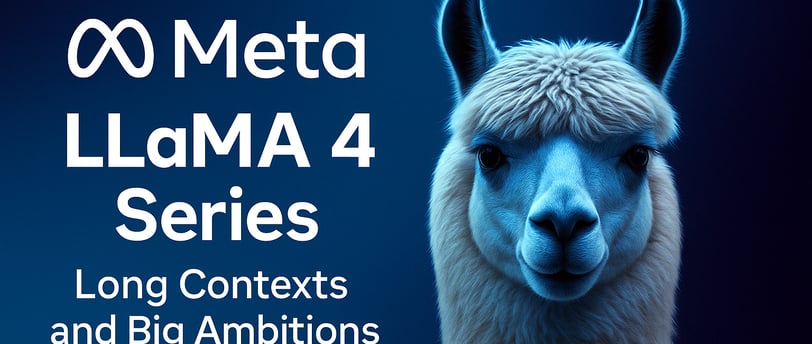Meta’s LLaMA 4 Series – Long Contexts and Big Ambitions
Meta’s new LLaMA 4 models offer up to 10M-token context, multimodal input, and a sparse Mixture-of-Experts design. Scout, Maverick, and the in-progress Behemoth rival top models from OpenAI and Google. While Meta claims they’re open source, license restrictions raise debate. This post covers performance, model specs, and what it means for developers.
4/16/20252 min read


Meta’s LLaMA 4 Series – Long Contexts and Big Ambitions
If you’re working on AI applications that require handling long documents, complex code, or combining text and images, Meta’s LLaMA 4 series introduces models worth your attention. With up to 10 million-token context windows, multimodal inputs, and efficient deployment using mixture-of-experts architecture, they open new possibilities for search, reasoning, and advanced assistants. However, commercial use comes with licensing constraints that developers should evaluate carefully.
Meta has unveiled its LLaMA 4 family of AI models, pushing the boundaries of context length and scale. The lineup includes LLaMA 4 Scout and LLaMA 4 Maverick – both 17B-parameter models using a mixture-of-experts design – and a preview of the colossal LLaMA 4 Behemoth still in development. Scout is optimized for efficiency and boasts an industry-leading 10 million-token context window ([1]), meaning it can read and reason over extremely large inputs (think entire libraries or codebases at once). Maverickis a more powerful multilingual model with a still-impressive 1 million-token context length ([1]), excelling at text and image understanding across 12 languages. Meta even notes that Maverick’s performance rivals OpenAI’s and Google’s latest models on many benchmarks, despite using fewer active parameters thanks to its sparse MoE architecture ([2]) ([3]).
These models are not just bigger in context – they’re also multimodal, handling text and images in one model. Meta reports that Scout fits on a single H100 GPU (with heavy quantization) and outperforms LLaMA 3 and rivals like Google’s Gemma on various benchmarks ([4]). Maverick, with 128 expert modules (totaling ~400B params), is fine-tuned as a flagship conversational AI – essentially Meta’s answer to a ChatGPT-like assistant ([3]). Meanwhile, the giant Behemoth model weighs in at 288B active params (2 trillion total) and is still being trained; Meta says this teacher-model already outperforms models like GPT-4.5 and Claude 3.7 on STEM benchmarks ([2]). Behemoth is expected to facilitate future breakthroughs but isn’t released to the public yet.
Notably, Meta continues to label LLaMA 4 as “open source,” but with some strings attached. In fact, the license restricts usage by very large platforms – any product with over 700 million users must obtain permission from Meta before using LLaMA 4 ([2]). (This condition, carried over from LLaMA 2’s license, has led the Open Source Initiative to argue LLaMA isn’t truly open source ([2]).) For everyone else, LLaMA 4 models are available to download or via partners (Azure, AWS, Cloudflare, etc.), heralding a new era of extremely long-context AI accessible to developers ([3]).
Overall, LLaMA 4 models expand the technical range of language models through long context windows, sparse expert routing, and multimodal input. These features enable use cases like document-level reasoning, cross-language processing, and code analysis at scale. Scout’s efficiency supports constrained hardware environments, while Maverick’s multilingual and image-text integration lends itself to global assistant tools. Behemoth’s larger design targets research and advanced STEM tasks. Commercial deployment requires review of licensing terms, especially for high-traffic platforms.
